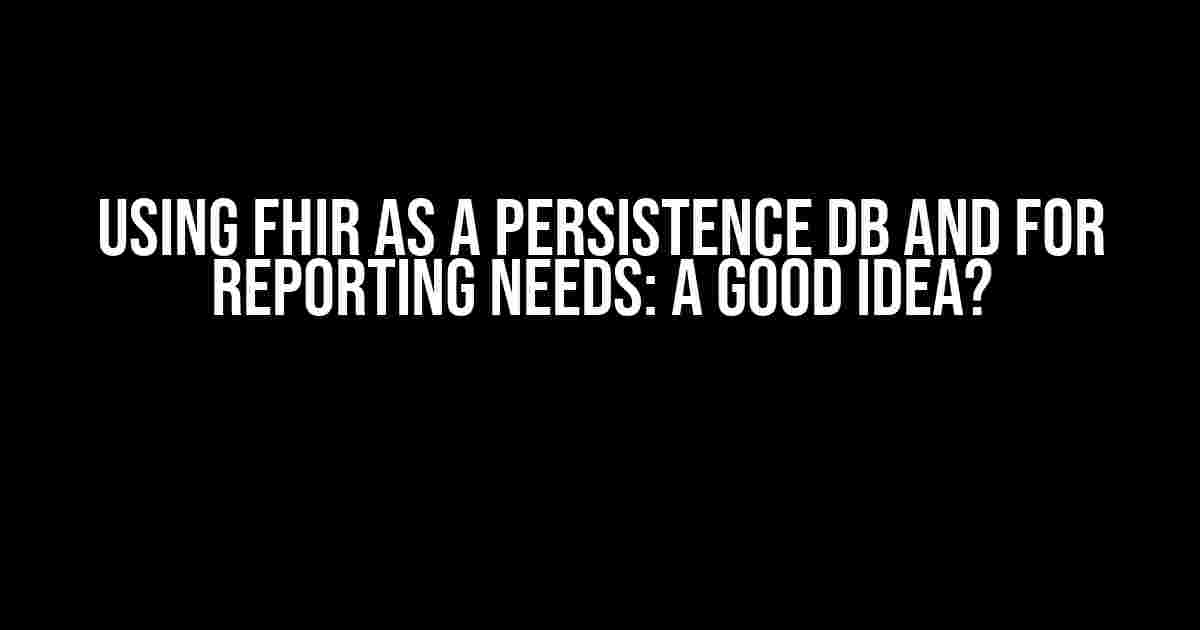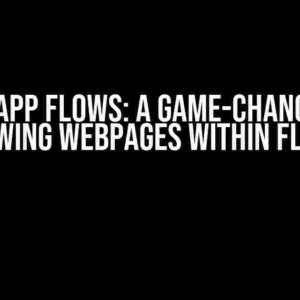FHIR (Fast Healthcare Interoperability Resources) has been gaining popularity as a standard for exchanging healthcare data between systems. But have you ever considered using FHIR as a persistence database and also to aid some of your reporting needs? In this article, we’ll explore the pros and cons of using FHIR in this way and provide guidance on whether it’s a good idea or not.
What is FHIR?
FHIR is a standard for representing and exchanging healthcare data between systems. It’s based on modern web technologies such as RESTful APIs, XML, and JSON, making it easy to implement and use. FHIR provides a set of resources that can be used to represent various healthcare data elements, such as patients, medications, observations, and more.
Using FHIR as a Persistence Database
Using FHIR as a persistence database means storing healthcare data in a FHIR-compliant database. This can be beneficial in several ways:
- Interoperability**: FHIR enables seamless data exchange between systems, making it an ideal choice for integrating with other healthcare systems.
- Standardization**: FHIR provides a standardized way of representing healthcare data, reducing the complexity and cost of integration.
- Scalability**: FHIR databases can scale horizontally, making them suitable for large-scale healthcare enterprises.
However, there are also some potential drawbacks to consider:
- Data Governance**: FHIR databases require robust data governance policies to ensure data quality, security, and compliance.
- Data Modeling**: FHIR’s data modeling is complex, and incorrect modeling can lead to data inconsistencies and errors.
- Performance**: FHIR databases can be slow due to the complexity of the data model and the overhead of JSON or XML processing.
Using FHIR for Reporting Needs
FHIR’s standardized data model and APIs make it an attractive choice for reporting needs. Here are some benefits:
- Easy Data Retrieval**: FHIR’s APIs provide an easy way to retrieve data for reporting purposes.
- Standardized Data**: FHIR’s standardized data model ensures consistency and accuracy of data, making it ideal for reporting.
- Flexibility**: FHIR’s APIs can be used to generate ad-hoc reports or to integrate with existing reporting systems.
However, there are also some potential challenges to consider:
- Data Volume**: Large volumes of data can be overwhelming and may require significant processing power.
- Data Complexity**: FHIR’s data model is complex, and incorrect data retrieval can lead to inaccurate reports.
- Security**: FHIR APIs require robust security measures to ensure data confidentiality and access control.
Is using FHIR as a Persistence DB and for Reporting Needs a Good Idea?
In conclusion, using FHIR as a persistence database and for reporting needs can be a good idea, but it’s not without its challenges. Here are some scenarios where it might make sense:
- New Implementations**: If you’re building a new healthcare system, using FHIR as a persistence database can provide a standardized and scalable solution.
- Integration with Existing Systems**: If you need to integrate with existing healthcare systems, FHIR can provide a standardized way of exchanging data.
- Reporting and Analytics**: FHIR’s standardized data model and APIs make it an attractive choice for reporting and analytics needs.
However, if you’re dealing with existing legacy systems or have complex data modeling requirements, you may want to consider other options.
FHIR Implementation Checklist
If you decide to use FHIR as a persistence database and for reporting needs, here’s a checklist to get you started:
Define your data model: Ensure you have a clear understanding of your data requirements and how they map to FHIR resources.Choose a FHIR-compliant database: Select a database that supports FHIR, such as a relational database or a NoSQL database.Implement FHIR APIs: Implement FHIR APIs to enable data retrieval and exchange.Develop data governance policies: Establish robust data governance policies to ensure data quality, security, and compliance.Test and validate: Thoroughly test and validate your FHIR implementation to ensure data accuracy and consistency.
Conclusion
Using FHIR as a persistence database and for reporting needs can be a good idea, but it’s essential to weigh the pros and cons and consider your specific requirements. By following the checklist and considering the scenarios outlined in this article, you can make an informed decision about whether FHIR is right for your healthcare organization.
Note: This article is not intended to provide medical or technical advice. It's essential to consult with experts in healthcare and technology before implementing FHIR or any other healthcare technology solution.
| Scenario | Pros | Cons |
|---|---|---|
| New Implementations | Standardized, Scalable, Interoperable | Data Governance, Data Modeling, Performance |
| Integration with Existing Systems | Standardized, Scalable, Interoperable | Data Governance, Data Modeling, Performance |
| Reporting and Analytics | Easy Data Retrieval, Standardized Data, Flexibility | Data Volume, Data Complexity, Security |
I hope this article has provided valuable insights into using FHIR as a persistence database and for reporting needs. Remember to consider your specific requirements and weigh the pros and cons before making a decision.
Frequently Asked Question
Using FHIR as a persistence database and aid for reporting needs, is it a good idea? Let’s dive into the details and find out!
Is FHIR primarily designed for persistence storage?
No, FHIR is primarily designed for exchange and interoperability of healthcare data, not for persistence storage. While it can be used as a database, it’s not its primary purpose.
Can FHIR be used for reporting needs?
Yes, FHIR can be used for reporting needs, especially for clinical and administrative data. Its standardized resources and APIs make it an excellent choice for generating reports and analytics.
What are some potential issues with using FHIR as a persistence database?
Some potential issues include data inconsistencies, data loss, and performance bottlenecks, especially when dealing with large amounts of data. Additionally, FHIR might not provide the same level of data normalization and querying capabilities as traditional databases.
Can I still use FHIR for reporting needs if I don’t use it as a persistence database?
Absolutely! You can still use FHIR for reporting needs by leveraging its APIs and data resources, even if you store your data in a traditional database. This way, you can take advantage of FHIR’s strengths in data exchange and interoperability without compromising your data storage and management.
What’s the final verdict? Is it a good idea to use FHIR as a persistence database and for reporting needs?
While FHIR can be used for both purposes, it’s essential to weigh the pros and cons carefully. If you’re already invested in the FHIR ecosystem, it might be a good idea to use it for reporting needs. However, for persistence storage, a traditional database might be a more suitable choice, depending on your specific use case and requirements.


